Throat diseases are quite common and require immediate attention. medical care. Often, a person experiencing any painful sensations in the throat area simply does not attach any importance to such a phenomenon and thereby neglects the state of his health. After all, pathologies of the pharynx are considered one of the most serious and dangerous diseases. The main diseases of the larynx include pharyngitis, laryngitis, sore throat, laryngospasm and throat cancer.
Pharyngitis
Pharyngitis is a disease that affects the mucous membrane of the larynx and is accompanied by inflammatory processes in it. This pathology of the pharynx can develop in both acute and chronic forms. The main causes of the disease lie in polluted or too cold air that a person inhales, as well as exposure to irritating substances on the mucous membrane of the pharynx, such as tobacco and alcohol. The infectious origin of pharyngitis is provoked by various microorganisms, which include staphylococci, pneumococci and streptococci. In addition, the disease can develop as a result of inflammatory processes located near the larynx. For example, for dental caries, rhinitis and sinusitis.
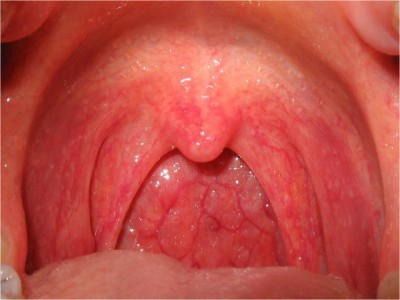
Acute disease of the throat and larynx is characterized by a direct effect on the mucous membrane of the throat of various infections or irritants. However, if the treatment provided for the disease was not effective or was simply not fully completed, then pharyngitis can become chronic, the treatment of which will be much longer and more difficult than acute pharyngitis.
In acute pharyngitis of the throat, its symptoms are expressed in a feeling of dryness, sore throat and pain during swallowing. In addition, there may be an increase in the size of the cervical lymph nodes. In adults, the course of the disease does not cause any serious problems against the background of general health, unlike children under 2 years of age, and may be accompanied by inflammatory processes not only on the mucous membrane of the pharynx, but also the nasopharynx. This makes it difficult to breathe through the nose. Chronic have the same symptoms as acute. The only difference between them is that the treatment of advanced pathological processes in the mucous membrane of the larynx takes much longer than when eliminating the acute nature of the manifestation of the disease.
Prevention of pharyngitis involves avoiding any bad habits, primarily from smoking and drinking alcohol. Frequent walks in the fresh air will help avoid the occurrence of such an unpleasant disease, especially for those people whose profession involves the possibility of inhaling harmful fumes and substances. In addition, changing your toothbrush can prevent the disease in the initial stages of its development. After all, a toothbrush can contain various bacteria, and if they enter the body during the next brushing of teeth through gums damaged as a result of some circumstances, this can cause not only pharyngitis, but also other diseases of the pharynx. Therefore, you should change your toothbrush regularly.
https://youtu.be/zn7P_ps6E1g
Laryngitis
Laryngitis is characterized by inflammatory pathological processes that. Its occurrence is most often associated with complications caused by various colds or with the impact on the human body of infectious diseases such as scarlet fever, whooping cough and measles. The causes that contribute to the occurrence of laryngitis are hypothermia, inhalation of cold or polluted air, abuse of alcoholic beverages and smoking. Throat diseases such as laryngitis have 2 forms of development: acute and chronic.
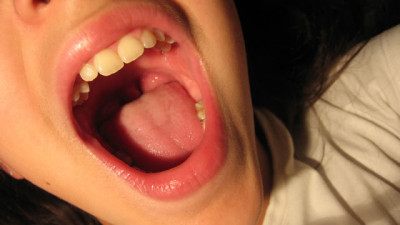
Acute is characterized by its short duration and, with timely treatment, lasts about 14 days. is formed as a result of the frequent occurrence of an acute form of the disease or as a result of any long-term inflammation in the nasal cavity and its sinuses. Quite often, chronic laryngitis is diagnosed in adults whose field of activity is related to teaching, and therefore this disease is considered professional. Signs of acute laryngitis are quite pronounced and manifest themselves in the form of poor health and pain during swallowing. At the same time appears. This is due to the fact that during the inflammatory process the vocal cords can be affected, changing the voice. There appears a sore throat, a cough, both dry and with mucus. Treatment of acute laryngitis generally lasts for 1 week.
Sore throat and its symptoms
Sore throat or tonsillitis is an acute infection of the tonsils and laryngeal tissues, which is caused by various viruses, fungi and pathogenic bacteria (streptococci). Absolutely anyone can become infected with tonsillitis, and this happens through airborne droplets, that is, through contact with a person suffering from tonsillitis or during contact with objects used by a sick person (for example, a towel or dishes).
Sometimes the risk of a sore throat can increase significantly if the human body is subjected to severe hypothermia or fatigue. Often the formation of this disease is promoted by inflammatory processes in the nasal cavity (sinusitis) or in the oral cavity (dental caries). In a child, this pathology can manifest itself as a result of poor nutrition, rare walks, and even slight hypothermia. In adults, sore throat is somewhat milder than in children.
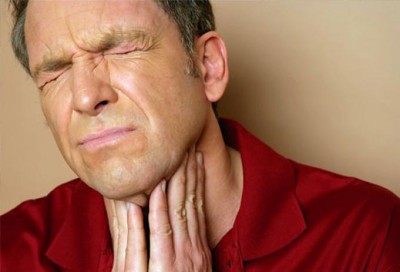
Symptoms of tonsillitis manifest themselves in the form of severe pain in the throat while swallowing food, an increase in body temperature to 39°C, general weakness and malaise, the throat becomes red, and the tonsils secrete purulent formations. Timely treatment will eliminate the disease within 1 week. If for some reason the pathology has become advanced, complications such as renal failure, inflammation of the appendix may arise due to infection in the gastrointestinal tract. However, the most dangerous is considered to be the entry of infectious organisms into the blood lymph, which leads to its infection and the spread of infection throughout all internal organs of a person. Therefore, to avoid possible complications It is necessary to consult a doctor at the first manifestations of tonsillitis.
Laryngeal cancer
Diseases of the larynx such as cancer are the most dangerous pathologies, affecting the mucous membrane of the throat. The disease is characterized by the appearance malignant tumors on the mucous membrane of the pharynx. Throat cancer primarily develops in adult men and women, with smoking being a major factor in its development. Symptoms in the early stages of pathology development are rather vague, but as cancer cells multiply, they become more pronounced:
- the voice becomes hoarse;
- arises persistent cough(mostly dry);
- foul breath appears (adult smokers often experience this phenomenon and therefore believe that the source is unpleasant odor are cigarettes and do not pay attention to it);
- lymph nodes become enlarged;
- spontaneous and severe weight loss, which is directly related to the development of malignant tumors in the larynx, causing pain when swallowing food.
Most effective treatment throat cancer is carried out using chemotherapy and radiotherapy, however, if the pathological processes of the disease have become irreversible, then in this case only surgical intervention can help. Therefore, in order to overcome throat cancer in the initial stages of development, you need to consult a specialist in time.
https://youtu.be/RORegShvc94
Almost all throat diseases that can be observed in humans manifest themselves against the background of the fact that the body is exposed to bad habits and harmful production factors.
Therefore, adhering to healthy image life and regular medical examinations, you can prevent and avoid various chronic pathologies!
Many adults and children often experienced this sensation while swallowing. They asked what to do if they had a sore throat, how to treat it at home. Today, there are many folk remedies that are widely used to treat the throat. The most effective of them are: rinses, products, infusions and inhalations.
The most effective gargles
In order to reduce painful sensations in the area are most often used, which help relieve pain.
In the presence of purulent discharge during a sore throat, beets are often used. This ingredient must be grated. The resulting pulp is squeezed through gauze or a piece of any other fabric. You should get one glass of beet juice. One tablespoon of vinegar is added to it. The resulting medicine should be gargled. It is absolutely harmless and is therefore used until the symptoms of the disease completely disappear.
Enough effective means To treat a sore throat, use cranberry juice.
- It needs to be ground and the juice squeezed out.
- The resulting mixture is mixed with honey in a ratio of 1:3 with honey and used for gargling.
Very often, throat treatment at home is done using quince seeds:
- They must be simmered over low heat for five minutes.
- The resulting decoction is filtered and used for...
- This folk remedy can be used no more than six times a day.
Dried pomegranate peels are also very often used as a gargle. They must first be crushed. The resulting mixture in the amount of one tablespoon is diluted with a glass of water and boiled. The resulting broth must be filtered and used to gargle. The procedure using this drug must be repeated no more than six times a day.
Many people have kombucha in their home, which is widely used to make kvass.
It can also be used as a gargle. Kombucha must be infused for 7-9 days. If the tincture is not sour, then the process of infusing the mushroom must be extended. Tea mushroom widely used for gargling.
When the first pain in your throat appears, you can use garlic to gargle it. To do this you need:
- Take three tablespoons of garlic, which is first very finely chopped or passed through a meat grinder.
- Garlic is diluted in a glass of water, infused for 10 minutes, filtered.
- The resulting infusion is used to gargle.
A decoction of spruce needles is also a fairly effective remedy for treating sore throats. Spruce needles are finely chopped and boiled in a container that is only half filled with water. The resulting decoction must be infused for several hours, and after that only used for gargling.
An herb called St. John's wort has excellent properties. To use it for rinsing you must:
- Take 200 grams of grass. She insists on half a liter of vodka.
- The resulting tincture is added to water in a ratio of 40:200.
- You can use this folk remedy no more than nine times a day.
Dry rowan or viburnum can also be used to treat a throat at home. Necessary:
- Take 50 grams of this raw material and boil in one liter of water.
- The resulting decoction should be gargled when the first pain symptoms appear.
A decoction of ordinary chamomile is often used for rinsing.
Absolutely all of the above methods are quite effective in treating a throat. This is explained by the fact that they are able to relieve not only pain, but also inflammation.
Decoctions and infusions in the treatment of throat diseases

Decoctions are characterized by the presence of an effect, which allows them to be fully used for. A fairly effective folk remedy is a medicine prepared from raspberry leaves and stems. This plant must be chopped very carefully. Take three tablespoons of it and pour one liter of water. The resulting medicine must be consumed in the form of warm tea. In order for the medicine to be more effective, it is necessary to add one teaspoon of honey per glass to the tea.
If they bother you severe pain in the throat, then you need to use lemon juice for treatment. It is quite effective in combating a variety of microbes. When lemon juice is used as a medicine, the possibility of development is blocked. It's quite simple to use. To do this, you just need to take a slice of lemon in your mouth and suck it. This procedure can be performed an unlimited number of times a day.
Quite often used to treat colds and sore throats.
This product is used in in kind for chewing. This procedure is performed only after eating. When choosing high-quality propolis, the patient will experience a slight burning sensation. Before going to bed, patients place this folk remedy behind the cheek or under the tongue. This will allow the medicine to fight throat diseases throughout the night.
A fairly effective treatment is a decoction made from figs. To prepare it you need:
- Take one tablespoon of finely chopped figs and boil in half a liter of water for three minutes.
- Next, you need to set the broth off the heat, let it brew and strain.
- The decoction should be taken half a glass five times a day.
If a sore throat is accompanied by loss, then it is necessary to use fresh horseradish to eliminate this problem. This product is mixed with walnut and infuse for 20 minutes in water. You need to add one teaspoon of honey to the resulting infusion. This medicine should be taken in small sips in the amount of one tablespoon.
Very often used to combat purulent diseases onion. To do this you need:
- Take an onion, peel it and squeeze out the juice.
- You need to take this medicine three times a day, one teaspoon.
- In order to increase its effect, it is necessary to drink the medicine as slowly as possible.
Radish is a fairly effective folk remedy in the fight against throat diseases. Black radish is used to prepare the medicine. large sizes. The top is removed from it. Next, using ordinary kitchen knife A hole is made in the radish. The resulting hole in the radish must be lubricated with honey. This vegetable is left in a warm place for 12 hours. It's best to do everything preparatory work in the evening so that the medicine is ready by morning. After 12 hours, juice forms in the radish, which must be taken one teaspoon at a time to treat the throat. The procedure is repeated three times a day.
Video. Treating a sore throat at home.
Tea is very effective for throat diseases. To prepare it you need to take a glass apple juice and mix with garlic, which is pre-chopped. The resulting mixture is brought to a boil and boiled for several minutes. It must be cooled and taken orally three times a day. This folk remedy must be taken one glass at a time.
Apple and onion pulp is also used to treat the throat:
- This paste is mixed with two tablespoons of honey.
- This medicine must be taken 3-4 times a day, no more than one teaspoon.
- The gruel must be eaten and not washed down with water.
All decoctions are very effective in treating throat diseases of various types. In this case, it is necessary to use only fresh folk remedies. Otherwise, their effectiveness will be significantly reduced.
Carrying out inhalations

In the presence of throat diseases, it is very often done. An infusion or decoction can be used as inhalers. With their help, inflammatory processes are relieved, as well as the level of throat soreness is reduced.
Today, there are several simple recipes for preparing throat inhalers.
To prepare inhalers, you need to take crushed leaves and flowers of plants such as:
- Chamomile
- Sage
- Mint
All ingredients must be taken in equal quantities, mixed and poured with one liter of boiling water. The resulting mixture is boiled over low heat for 5-7 minutes. The resulting broth should cool slightly. It must remain in a container wide enough to allow full carrying out. You need to place your head over the container with the decoction. The head is covered with a towel on top to extra steam did not evaporate. The steam must be inhaled slowly through the mouth.
St. John's wort will be quite effective as an inhaler.
You can collect it yourself or purchase it at a pharmacy. A decoction can be prepared from the obtained raw materials. To do this, crushed St. John's wort leaves are mixed with chamomile and poured into one liter warm water. The resulting mixture should simmer for five minutes. Add a few drops to it essential oil from coniferous species tree. You need to breathe through your mouth over the decoction for 15-20 minutes.
In order to get rid of sore throat, you can lubricate the tonsils:
- For this purpose, an aloe leaf is taken, the pulp is removed from it and crushed.
- The resulting mixture is diluted with three teaspoons of honey and used to lubricate the tonsils.
- This action is performed only after taking food and water.
A child's throat is defenseless against many inflammatory diseases. Its mucous membrane is very sensitive and, in direct contact with air, is constantly exposed to the aggressive effects of harmful agents. climatic conditions. Even the youngest children under one year of age are susceptible to diseases. The throat consists of the pharynx and larynx, some pathologies affect both parts.
Diseases of the pharynx
Pharyngitis can be caused by diseases such as sinusitis, fungal stomatitis, caries, ARVI, measles, influenza and rhinitis. The mucous membrane of the pharynx - the upper part of the throat - becomes inflamed. The disease can be caused by excessive cooling or overheating, prolonged inhalation of chemically irritating gases, dust, smoke, smoking, drinking alcoholic drinks. The infectious, bacterial form is provoked by staphylo-, strepto- and pneumococci, adenoviruses or influenza viruses, and a fungus - pharyncomycosis.
Symptoms of pharyngitis:
- swelling and redness of the mucous membrane, sometimes with the formation of ulcers, a whitish or yellowish coating
- painful spasms in the walls of the pharynx, intensifying when swallowing, sometimes radiating to the ear
- enlarged cervical lymph nodes, pain on pressure
- soreness, dryness, burning sensation in the throat
- dry cough
- headache
- temperature 37-38°
- general malaise
Pharyngitis can occur in acute or chronic forms. The latter is quite severe, the stages of exacerbation and remission - weakening or disappearance of symptoms - alternate. Types of pharyngitis in children: hyperplastic, atrophic. The disease is diagnosed by interviewing the patient, his parents, pharyngoscopy - examination, and laboratory tests of throat smears.
Many types of pharyngomycosis have been discovered, which vary depending on the causative fungi:
- candidiasis (yeast fungus Candida)
- cryptococcosis
- aspergillosis (Aspergillus)
- penicillium (Penicillium)
- leptotrichosis (Leptotrix buccalis)
- actinomycosis
Treatment of pharyngitis depends on the causes of its occurrence. The therapeutic course may include antifungal drugs, oral or local antibiotics: aerosols, solutions for rinsing and inhalation, physiotherapy and vitamin therapy. In the chronic form of the disease, anti-relapse therapy is carried out during the period of remission. In case of fungal infections, measures are necessary to restore the intestinal microflora - taking Bifidumbacterin, Colibacterin, Lactobacterin, Acipol, Baktisubtil, Hilak-Forte, Linex.
Prevention of pharyngitis caused by living in unfavorable conditions- use of humidifiers, individual funds protection, such as respirators. To keep your throat healthy, you need to avoid sudden changes in temperature, dress appropriately for the weather, do not eat irritating foods, and treat ENT diseases in a timely manner.
Tonsillitis can occur in acute or chronic forms. Sore throat - exacerbation of a chronic form or acute tonsillitis - local inflammation of the pharyngeal and palatine tonsils caused by infection:
- pneumo-, strepto- and/or staphylococci
- Moraxella
- adenoviruses
- enterovirus Coxsackievirus
- herpes viruses, Epstein-Barr
- Vincent's spirochete and spindle-shaped rod
- fungus - tonsillomycosis
- chlamydia
Acute tonsillitis is often confused with pharyngitis, but they differ in symptoms. With a sore throat, there is no dry cough or burning sensation in the throat, and the temperature often rises to 40-41°. Acute tonsillitis can be a symptom of scarlet fever. 
The methods for diagnosing a sore throat do not differ from those that an ENT doctor uses for pharyngitis: conversation, examination, collection of biomaterial from the tonsils and the surface of the pharynx. These samples are needed for examinations such as:
- sowing on a nutrient medium where pests actively reproduce, facilitating diagnosis
- PCR analysis of polymerase chain reaction of DNA fragments
- rapid antigen test
- Colonies of microorganisms obtained in laboratory conditions are used to select the most effective antibiotic.
Treatment of sore throat. Asphyxia requires emergency intubation and tracheotomy. A gentle regimen is necessary: you need to lie down, follow a special diet, and drink a lot. Most often, antibiotics and antiseptics are prescribed locally. Medications are accepted in a wide variety of forms:
- sprays for irrigation
- regular and chewable tablets
- solutions for rinsing or inhalation
- drops for oral administration
- lollipops
- lozenges
- throat lubricants
Sore throat is very contagious. It is advisable to isolate the patient from other children; he should eat from a separate container and be in a well-ventilated area. The disease is fraught with attacks of suffocation.
Chronic tonsillitis can be a consequence of tonsillitis, diphtheria, scarlet fever or measles. The relapse prevention course is carried out twice during the year: in autumn and spring. In rare cases it is required surgical intervention– removal of tonsils. This is a last resort, because... these glands have important for the well-being of the immune and hematopoietic systems. A strong preventive measure for chronic tonsillitis is hardening.
Laryngitis occurs against the background of acute respiratory infections, scarlet fever, whooping cough and measles. Laryngotracheitis also affects the initial parts of the trachea. The distinctive symptoms are hoarseness up to aphonia - loss of voice - due to inflammation of the vocal cords and the possibility of a wet cough. With difficulty breathing, bluish skin appears.
The patient should not speak even in a whisper. The course of treatment consists of following a special diet with warm drinks, taking antihistamines, inhalations and rinses. If timely treatment measures are not taken, the acute form of the disease becomes intractable chronic.
Children may develop false croup - acute stenosing laryngotracheitis. An attack of asphyxia looks terrifying: the child breaks out in sweat, breathes wheezing, lips and fingers turn blue. The first attack most often begins at night on the second day from the onset of the disease, then the attacks can be repeated several more times. It is better to transfer the child to a hospital.
False croup has 3 degrees of severity. Sometimes hormonal treatment is required. Children with croup are usually hospitalized to remain under medical supervision at all times. If swallowing has become impossible, nutrient solutions and medications are administered parenterally: through injections, droppers and inhalations. The most severe form of the disease requires intubation and tracheotomy.
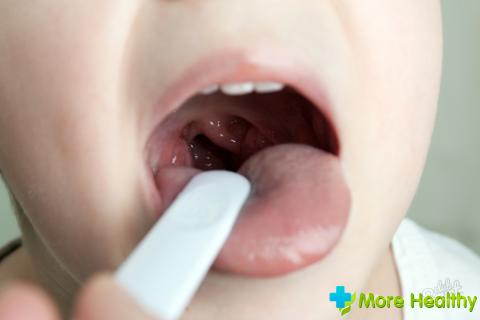
Phonasthenia – “weakness of sound” – is due to neurological reasons. Occurs in children who sing professionally and often cry. U junior schoolchildren there may be pseudophonasthenia, when their voice begins to break from excitement.
For an accurate diagnosis, Lombard’s experience is used: the patient is “deprived” of hearing, for example, by wearing headphones with loud music, and then he must utter a few words. By losing control of pronunciation, the child gives the doctor the opportunity to determine how damaged the vocal cords really are. Treatment methods:
- complete peace
- breathing exercises
- physiotherapy
- massage
Adenoiditis is a disease in which the pharyngeal tonsil enlarges so much that it makes nasal breathing difficult and reduces hearing. Based on the size of the lumen in the nasopharynx, 3 degrees of adenoid development are distinguished. The third is the most severe, posing a danger to the patient’s life. The adenoids become so enlarged that they make breathing difficult.
This occurs due to the rapid proliferation of the lymphoid tissue from which they are composed. Most often, adenoids occur in preschool children. Their the immune system is still very weak and the nasopharynx is small.
Diphtheria is caused by the bacterium Corynebacterium diphtheria (Leffler's bacillus) and can affect various organs or the body as a whole. A distinctive symptom of the oropharyngeal form is swelling of the neck, the formation of films in the pharynx. This infection is very dangerous because... spreads quickly through airborne droplets, household contact and food routes. Hospitalization is required.
The disease is extremely difficult, because The diphtheria bacillus causes severe intoxication. The development of croup is possible when the oropharynx is completely blocked by diphtheria films. Treatment is carried out with anti-diphtheria serum - antitoxin. For preventive purposes, vaccination is done. This will not protect against infection, but will significantly ease the course of the disease. 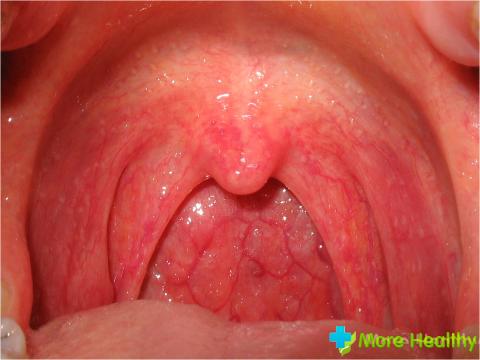
Diseases of the larynx
Stridor is a rough sound caused by the passage of air through a pathologically narrowed area of the upper respiratory tract. Most often the disease occurs in infants. Depending on the volume, pitch and time when it is most audible, several types of illness are distinguished. When diagnosing, many factors are taken into account: the age of the child, the nature of crying, the feeding process, regurgitation, heart rate, cough, general condition, skin color.
X-rays, ultrasound, CT, MRI are prescribed. The most informative diagnostic method is endoscopy. Treatment up to surgery is only necessary in very severe cases, which are extremely rare. Usually no measures are taken; the child “grows out” of this disease by the age of 3.
Stenosis can occur suddenly and be accompanied by suffocation - acute form or develop gradually - chronic. This is a pathological narrowing of the larynx. In children, the lumen of the larynx is smaller due to the “overhanging” soft epiglottis, this is an age-related feature. Allergies and any other manifestations that lead to swelling of soft connective tissue threaten hypoxia.
An attack of asphyxia is accompanied by such phenomena as:
- rare heartbeat
- shortness of breath, respiratory arrest
- pale skin
- dilated pupils
- lethargy
- fainting
- exophthalmos - bulging of the eyes
- involuntary bowel movements and urination
- death
- Treatment methods for stenosis:
- warming compresses
- warm foot baths
- warm alkaline drink
- Seduxen, Relanium or sodium hydroxybutyrate solution intravenously
- Prednisolone, Eufillin, Hydrocortisone, Sodium bicarbonate, Heparin, Korglykon, Strophanthin
- surgical intervention
With laryngeal stenosis, as with other diseases of the respiratory tract, the most important thing is timely diagnosis and constant monitoring of the child’s condition.
Laryngospasm is a sudden involuntary muscle contraction. The cause of this occurrence in young children is vitamin D deficiency. An attack can occur during crying, laughing, coughing, or when frightened. The head falls back, the baby convulsively gasps for air, breaks out in a cold sweat, his neck muscles cramp, and his pulse disappears. Fainting and foaming at the mouth may occur.
Attacks may occur several times during the day. Laryngospasm has the potential to be fatal. The patient needs fresh air, a course of vitamin therapy, ultraviolet irradiation, and a dairy-vegetable diet. To prevent attacks, enemas and injections with solutions are given as prescribed by the doctor. As you age, your likelihood of having seizures decreases.
Scleroma can develop in both the pharynx and larynx. This is an infection with the Frisch-Wolkovich bacillus. First, small dense red nodules appear on the mucous membrane - the initial stage. They grow quickly - the active stage. An ulcer appears at the site of the nodule, which then scars, forming a thickening on the mucous membrane and narrowing the lumen - the cicatricial stage.
The course of treatment includes taking medications (Streptomycin, Embiquin), radiotherapy, and inhalations. Pharyngeal scleroma is only one of the varieties of this disease. There is only a chronic form with periods of exacerbations. If the initial stage has already passed, it is completely impossible to recover. The disease is dangerous because it causes a complete loss of strength and quickly affects the entire respiratory system. 
Benign tumors
Polyps, hemangiomas, lymphangiomas, cysts, fibromas, lipomas, chondromas. Most often, papillomas grow in the larynx.
Papillomatosis – viral disease. May be due to hereditary predisposition. More common in young boys. How younger child, the more papillomatosis progresses.
For diagnosis, laryngoscopy and biopsy for histological examination are used. In order to determine whether the disease has invaded the trachea, bronchi and lungs,opy, X-ray, and computed tomography are prescribed. Papillomas have the appearance of papillae that change color during the course of the disease from red, pale pink to white. Surgical treatment methods are used more often. Recurrent papillomatosis can lead to scarring of the larynx due to multiple operations, which leads to stenosis.
Malignant tumors
Malignant neoplasms can occur anywhere in the throat. Pharyngeal cancer in children is often confused with adenoids. To accurately diagnose any neoplasm, computed tomography is necessary. Then a biopsy is performed.
Surgical treatment does not produce results, because... malignant cells quickly grow into bone tissue. Therapeutic methods: curie and deep radiation therapy, cobalt and chemotherapy. They can extend the patient's life by several years. The prognosis is unfavorable.
All throat diseases occur with inflammation of the mucous membrane and are caused by hypothermia, polluted air or infections. Genetic predisposition also plays a role. The symptoms of throat diseases are quite similar.
Possible complications: otitis media, dermatomyositis, tracheobronchitis, glomerulonephritis, retention mental development, pneumonia, meningitis, sepsis, mycosis internal organs, phlegmon of the neck, acute rheumatic fever, acute cervical lymphadenitis, periarteritis nodosa, psoriasis, eczema, multiform exudative erythema, systemic lupus erythematosus, Behcet's disease, hyperthyroidism, abscess, chondroperichondritis. This impressive list indicates the need for emergency treatment of any throat disease in children.
Most often, children with weakened immune systems are susceptible to throat diseases due to HIV, frequent acute respiratory viral infections, tuberculosis, diabetes mellitus obese patients after a course of chemotherapy. Provoking factors are also: local and general hypothermia, tonsil injuries, impaired nasal breathing, inflammatory processes in adjacent organs.
In the attached video you can learn about sore throat.
If unusual sensations occur in the throat, the child’s first complaints, a change in his voice, or difficulty breathing, it is advisable to examine the baby’s throat and contact an otolaryngologist. Children's throats are still small, so if inflammation occurs, accompanied by swelling, there is a risk of suffocation and death. Parents should remember the harm that even a short-term lack of oxygen brings to the body. It is important to prevent the pathological condition from becoming chronic, when the prognosis for recovery is less favorable.

